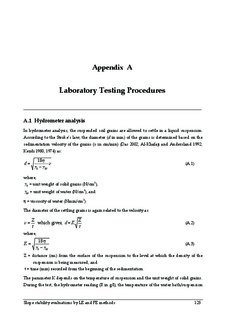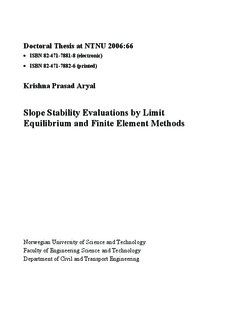| dc.description.abstract | This thesis deals with slope stability evolutions carried out by commonly used limit equilibrium (LE) and finite element (FE) methods. The study utilizes two LE based software (SLOPE/W and SLIDE) and one FE based software (PLAXIS). The principal difference between these two analyses approaches is that the LE methods are based on the static of equilibrium whereas FE methods utilise the stress‐strain relationship or constitutive law.
To fulfil one of the aims of the study, the LE based methods are compared based on the factor of safety (FOS) obtained for various load combinations. The comparison is mainly based on simplified slope geometry and assumed input parameters. Among the LE methods, the Bishop simplified (BS), Janbu simplified (JS) and Janbu GPS methods are compared with the Morgenstern‐Price method (M-PM). The two latter methods satisfy both force and moment equilibriums. In addition, M-PM allows a variable interslice force function. These LE methods are well established for many years, and thus some of them are still commonly used in practice for stability analysis. Simplicity and relatively good results are the advantages of these methods.
The comparative study among the LE methods shows that BSM is as good as M-PM for normal condition in circular shear surface (SS) analysis. Similarly, JSM is as good as M‐PM for plane SS analysis. Moreover, the study shows that BSM is insensitive to interslice forces in circular SS analysis, whereas JSM is insensitive to interslice forces in plane SS analysis.This is true for the analyses without any external forces acting in slopes. With some external forces, both methods may be sensitive to the interslice force function, and thus the analyses may result in either higher or lower FOS compared with M-PM. Even if the M-PM assumes an interslice force function in analysis, the method is found suitable, because the method satisfies both force and moment equilibrium conditions. The comparison between Janbu’s GPS method and the M‐PM shows a very good agreement with nominal difference (<2%) in the FOS.
Moreover, the M-PM has been compared with results from the FE analyses. Compared with the FE (PLAXIS) analyses, the LE (M-PM) analyses may estimate 5 – 14% higher FOS, depending on the conditions of a dry slope and a fully saturated slope with hydrostatic pore pressure distributions. For fully saturated conditions in the slope, inaccurate computation of stresses in LE methods may have resulted in larger difference in the computed FOS.
Since, the FE software is based on stress-strain relationship, stress redistributions are surely better computed even for a complicated problem. This has been found one of the advantages in FE simulations. A parameter study shows that the application of a positive dilatancy angle in FE analysis can significantly improve the FOS (4 - 10%). On contrast, the shear surface optimization in LE (M-PM in SLOPE/W) analysis results in lower FOS, and thus minimizing the difference in FOS compared with FE analysis. Thus, the optimisation of the circular SS in LE analyses and application of dilatancy angle in FE analyses may provide very good agreement in FOS keeping the variations less than 5%.
Instability of natural and built-in slopes has been a serious geotechnical challenge, particularly in mountainous countries like Nepal, where a large number of water-induced disasters are experienced every year. Since the country lies in a relatively active earthquake zone, earthquake events may adversely affect the long-term stability of slopes along the highways, around hydropower installations and elsewhere. The selected case study from the Middle Marsyangdi Hydroelectric Project (MMHEP) in Nepal was carried out, focusing on both the groundwater and earthquake effects on long-term stability of slopes. In addition, the analyses were performed for pore pressure distributions by seepage analyses and pseudo-static and dynamic earthquake events imposed in the case slopes.
Another important contribution of this study has been the investigations of the shear strength parameters for the case study slopes. The investigation ranges from the basic index tests, which were carried out to characterize material properties and establish a basis for building-in the test specimens, to the most advanced triaxial tests. Additionally, both consolidated drained and undrained triaxial tests were conducted, aiming to find any differences in the strength parameters. A total of twenty-four triaxial tests from four different soil samples, taken from the case study slopes, were conducted to define the Mohr-Coulomb failure envelope, and thus obtained the effective shear strength parameters (c’, φ’) for stability evaluations. In addition, the coefficients of permeability were investigated as an important input for seepage analyses.
Two slopes, one located at the dam site and the other at the powerhouse of the MMHEP, were evaluated for long-term stability conditions. The study, carried out using the monitored groundwater table, reveals that the groundwater is the potential destabilizing factor in the slopes. Both hydrostatic pore pressure distributions with phreatic surface correction and seepage analysis were carried out in the stability analysis. The pore pressure distributions from the seepage analyses indicated critically stable slopes particularly at the toe areas. However, a significant improvement in the FOS was found with lowered groundwater table. Moreover, the study, carried out for the pseudo-static analysis with the selected earthquake acceleration coefficient, shows that otherwise stable slopes become critical in earthquake events. However, the case slopes were found to have higher FOS than the recommended minimum value for such conditions. The dynamic earthquake simulations indicate both positive excess pore pressure and suction developed during the earthquakes. The applied earthquake acceleration of 0.15g (35% of PGA, where PGA = 4.2 m/s2)) shows critical conditions in the slopes. Moreover, larger accumulated displacements were found close to the slope surface compared to the inner side of the slopes. In addition, the dynamic analyses further indicate plastic points all over the slopes and increased shear strains in a particular location.
Nevertheless, the difference in FOS found from the LE and FE analyses may have a little interest, if there is a large uncertainty in the input parameters. Therefore, priority should be given to investigate the shear strength parameters and precise mapping of the slope geometry before selecting an appropriate analysis method. Most preferably, a slope should be analyzed by FE methods, else otherwise by LE based M‐PM or GPS method with investigated input parameters. | nb_NO |

